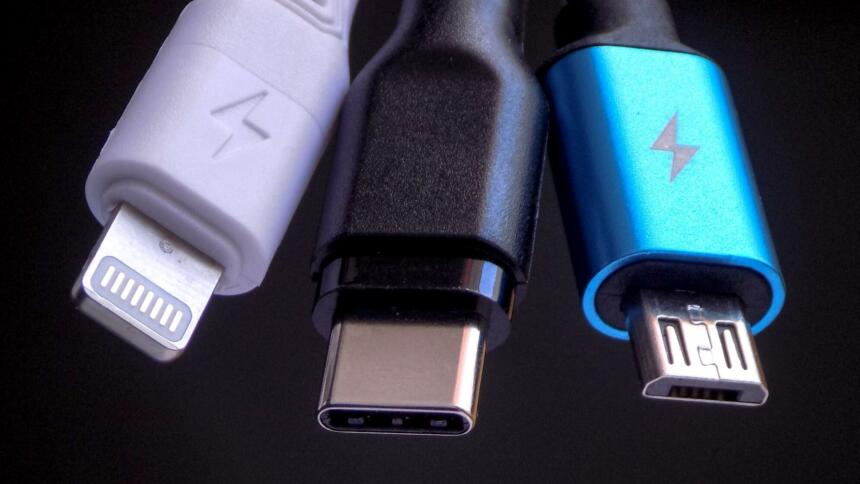More than a decade ago, the European Commission announced a universal charger for all phones, but the initiative stalled due to the EU’s lack of assertiveness and resistance by one major manufacturer: Apple. However, the Commission wants to make a new attempt this year, as internal documents reveal.
The EU plans to force manufacturers to adopt a common charger for mobile phones, tablets, laptops and other electronic devices. Internal Commission emails and documents, which netzpolitik.org obtained through a freedom of information request, show preparations for a new law are underway in Brussels.
Currently, there are three different charging ports on the market: older Android phones use Micro-USB, newer ones rely on the USB-C standard and Apple uses its own Lighting port for iPhones. With the spread of wireless charging, the market faces further fragmentation, environmental campaigners say.
EU proposals attempt to curb e-waste
According to an internal timetable for the Circular Electronics Initiative, a legislative proposal prescribing a uniform charger for different devices could be ready as early as this summer.
The initiative is meant to include devices with similar power requirements, including headphones, cameras, e-readers, portable speakers and fitness trackers, said a commission official who requested not to be quoted by name. The official said the Commission was still examining the legal basis on which the single charger could be introduced.
Along with unifying connecting ports, the Commission wants to create incentives so that a charger is not sold with every new mobile phone.
An study commissioned by the EU estimates that mobile phone chargers will generate up to 13,300 tonnes of electronic waste per year between 2020 and 2028. In future, users should continue to use old devices instead of getting an additional one with every new phone. This „decoupling“ is crucial from an environmental point of view, the Commission believes.
Currently less than half of e-waste is recycled. And only 12 percent of the EU’s raw material needs are currently met from recovered materials.
„The urgency to reduce the impact arising from our growing consumption of digital devices could not be overstated,“ says Ernestas Oldyrevas, a policy expert with the environmental group ECOS.
If the EU comes up with an ambitious plan for uniform standards for many devices, there is potential to save about 29,000 tonnes of e-waste per year, Oldyrevas says. That is equivalent to 70 times the weight of the International Space Station.
Study zeroes in on wireless charging
The Commission wants to create a uniform standard for wireless charging as well. Many new phones like the iPhone 12 can be charged with wireless Qi charging devices. But with Powermat, there already is a competing standard and others could follow.
The EU could prevent different solutions from emerging for wireless charging. To explore possible options for regulatory action, the EU Commission has commissioned a technical study, according to a document we have obtained.
Wireless charging may be more convenient, but it consumes up to 47 per cent more electricity according to tests. A study by UK researchers also suggests that inductive charging causes batteries to break down more quickly.
It must be ensured that wireless chargers are at least as energy-efficient as conventional ones, says NGO expert Oldyrevas. Here, too, a uniform standard is necessary. Otherwise, attempts to shrink the mountains of electronic waste will come to nothing.
Apple has frustrated EU designs for a decade
The European Commission first announced a universal charger for mobile phones in 2009, but at that time Brussels relied on voluntary agreements with the industry. Since then, nearly all phone manufacturers have switched their devices to USB ports, only Apple refused and in 2012 launched its own charging port called Lightning for iPhones.
Apple has so far undermined efforts to create uniform chargers and connectors for all mobile phones. The Silicon Valley company argues that this harms innovation. However, a recent study by the Commission found that different chargers are impractical for consumers and can lead to more electronic waste.
After a decade of stalemate, the EU parliament has recently made a renewed push for a common charger. In return, the Commission has promised „regulatory measures on chargers for mobile phones and similar devices, including the introduction of a common charger“. A proposal was planned for 2020 but postponed amid the pandemic.
The Commission’s plan for the Circular Electronic Initiative contains not only proposals for a common charger, but also a „right to repair“ including a right to update obsolete software. It will also call for better recycling of out-of-use devices.
But some officials want to go beyond the plans announced so far. In a document published by netzpolitik.org, the Directorates-General for the Environment and for Energy make the case for an overhaul of the Ecodesign Directive, which sets mandatory ecological requirements for household appliances.
The overhaul could create uniform chargers and connectors for a wide range of electronic devices such as 60-inch televisions, „or even cleaning, gardening, and a number of battery-powered DIY and professional tools“, the document states.
Should the EU decide to move into that direction, toasters and power drills could soon share a standard charging device with phones and computers.



0 Ergänzungen
Dieser Artikel ist älter als ein Jahr, daher sind die Ergänzungen geschlossen.